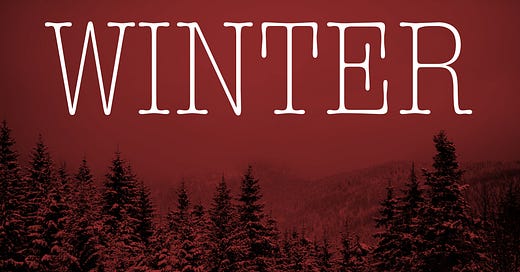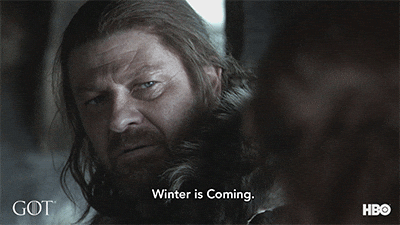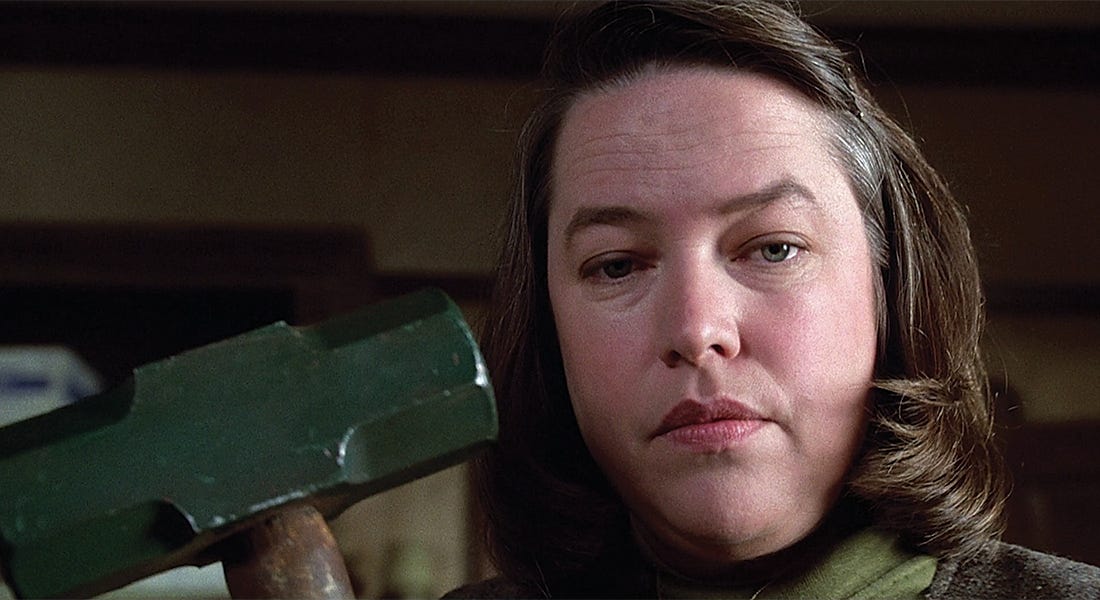Like any other season, winter has its own unique beauty. While trees may lose their green luster, the ground is covered in sparkling white sheets of snow. The nipping wind is cause for us to bring out the hot drinks, like cocoa and cider, to stay warm and cozy during the icy months. We get to experience the peak of fresh citrus and root vegetables, cooking up hearty seasonal meals.
Yet, there's a long term fear surrounding winter.
Our modern world has made the winter a lot more bearable for most people, but that doesn’t mean there’s no longer any threats. Blizzards, after all, are still a very real and prevalent thing. While snow storms are horrifying by their own right, the effects that come from them can be just as terrifying.
Horror films often delve into this idea, portraying winter itself as an unrelenting adversary.
ISOLATION
While all of the films I will be discussing here explores the idea of isolation, The Shining exemplifies the entire concept through its eerie use of design. The entirety of the Overlook Hotel, which stands secluded in a snow storm during the movie, is made up of liminal spaces. The giant, empty rooms are meant to cause an emotional response of general unease.
These grand rooms, meant for large gatherings, are stranded. They mirror the family trapped inside the Overlook, isolated from civilization. These spaces serve as constant reminders to the family that they are completely and utterly alone, with not even the concept of illusion being able to save them.
Outside, you have no town to save you. Inside, you have no guests to talk to.
Swallowed by the interior, your screams of desperation will only echo off the walls. Even if you make it outside into the harsh winter landscape, your scream will travel into a void.
When you watch The Shining, the fear you experience isn’t necessarily from Jack Torrance. While his mind slowly unravels due to the nature of the Overlook Hotel, the real fear comes from the atmosphere. Jack is a villain, yes, but he’s also a victim of the hotel’s wrath.
Jack is the vessel of what the hotel represents: a haunting reminder of being alone. Jack has no socialization with anybody outside of his family, and even that is limited as he focuses solely on writing his novel.
His mind is elsewhere throughout the entire movie. He was never actually there, despite seeming somewhat normal. Jack Torrance is the personification of a liminal space.
When you’re isolated for months on end, the fear of being alone begins to wear on you. In Jack’s case, it caused his eventual downfall and demise, freezing to death to forever be ingrained in the hotel’s history.
PARANOIA
"Nobody trusts anybody now, and we're all very tired." - R.J. Macready
With isolation comes paranoia. The Thing is a masterclass film in using paranoia as its main fear factor.
The crew may be isolated in the middle of Antarctica, but they’ve come to accept that. It’s their job, after all, to stay there and do research. They entertain themselves just fine anyway.
For the characters in The Thing, seclusion isn’t an issue. The problem is the movie’s title creature.
With a monster that’s able to take the shape of whatever or whoever it wants, this classic 1982 film blends the harsh reality of winter with the devastating horror of distrust. As the “thing” makes its rounds throughout the crew, they all begin to have distaste for each other, uncertain of who they can trust.
Widespread paranoia runs rampant on the research base, through it remains grounded in reality.
Paranoia itself is a powerful tool for horror. We humans tend to scare ourselves with our anxieties, so when a film takes advantage of our brains, we get a little unsettled.
The Thing makes us question our own reality. Who should you trust? Who is the snake in your life? Should you be watching your back? For most people, these aren’t really questions we should worry about, but this film forces our mind to wander.
Furthermore, the setting of The Thing being in a harsh climate like Antarctica makes it all the more unsettling. The characters that face the monster have nobody to rely on it. They can’t go get help or call for help, and there’s nobody that’s going to hear them scream.
They’re not just fighting a monster, they’re fighting mother nature as well. Blistering cold and shapeshifting creatures aren’t exactly the best duo.
The crew have to fight this thing alone. Not even teamwork can save them.
MANIA
What’s worse than facing your own paranoia and isolation? The mania of others.
Ol’ Jack Torrance may fall into this category, but he’s not hogging the spotlight here. No, this trophy belongs to none other than Annie Wilkes.
When author Paul Sheldon gets into a car crash, Annie Wilkes saves him. As a former nurse, she knows how to treat his injuries, and is able to provide help during the snowstorm. She also just so happens to be his biggest fan.
While this may seem like the perfect coincidence, Paul soon finds out that Annie is actually obsessed with his novels, to the point that she becomes livid when he kills off her favorite character.
Annie is mentally unwell, and her mental illness is cause for concern as she spirals into a months long mania over Paul’s writing.
She tortures him physically and mentally, breaking his legs and forcing him to continue his novel series for her to approve.
Misery encapsulates the very real dangers of winter. During blizzards, car wrecks, looting, and other dangerous activity is very much present. People become reckless and manic during their time trapped inside their homes, seeking a thrill to escape the confines of their safety.
In Paul’s case, what he thought was his safe space ended up being a disaster. Annie’s mania causes Paul extreme distress, keeping him isolated from the world. He develops high levels of paranoia, borderline drug addiction, and becomes handicapped by the end of the film.
But Annie never hurt Paul out of thrill. She was already mentally sick before she isolated herself from the world, but being alone in a cabin 24/7 has its effects on people all the same. When Paul killed off the one thing that brought her joy, she had no issues feeling the need to fight dirty.
Winter can be scary. For some, it poses the threat of starvation. Others, the scarcity of warmth.
In our case, it’s not the weather itself that causes horror, but the how people react to it.
Stay warm, friends.













Stephen King seems to have a knack for work in this sub-genre. The fact that he was born and raised where this stuff is a fact of life may have helped.
Great article on three of my favorite films! In all these winter does feels like a villain itself. In keeping with King the 1990’s mini series Storm of the Century is another adaptation of his (not on the same level of quality as these but still good) that would fit into your theme here of winter horror. A Maine island town is shut down in a brutal snow storm and a malevolent visitor arrives asking the unimaginable of them. Recommend this if you’ve not seen it and are looking for a strong horror in the snow movie around the holidays.